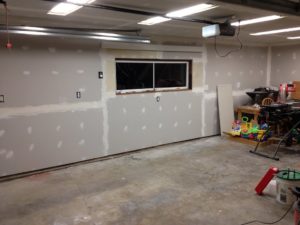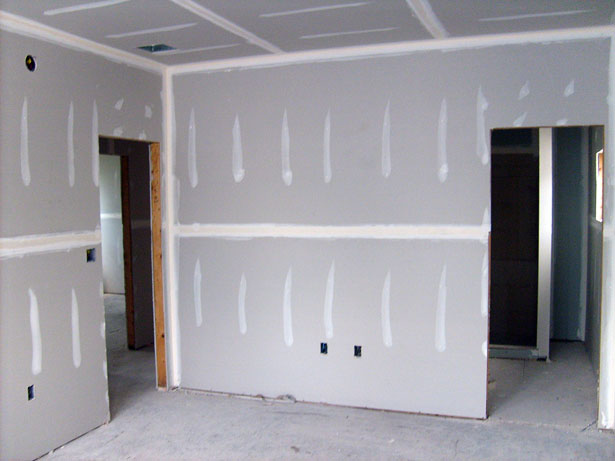Are you wondering what is Drywall? Don’t fret. We have answered all your questions. Read this article to learn about Drywall, its alternatives and necessary tools needed for drywall repairs.
What is Drywall?
Drywall is also known as wallboard, sheetrock, or gypsum board is a large, rectangular-shaped sheet that can be stacked in construction sites and stores. It is a fundamental part of the office, home, shops, and stores nowadays. It adds a definition to the building because of arches and niche.
These first came into the construction scene back in 1916. It is made with a gypsum-based paper and plaster. It is easy to repair drywall than plaster. The installation of drywall is also easier and quicker and fire-resistant.
The manufacture of drywall is done in sheets. It can be installed by nailing to wooden supports instead of requiring many laths to support like a plaster. A complete wall can be prepared in a few days, unlike plaster where it takes weeks to make a wall.
Drywall has many advantages yet it took several years for it to gain popularity in the construction market. It was during World War II when it gained popularity because of efficiency and lower prices. Drywall is a dominant construction material now used for interior construction walls.
Drywall Alternatives:-
There are variants or drywall alternatives available in the market depending on the requirement and installation place. Drywall has tapered edges on the long side of the sheet; it creates an invisible finish in the joints. Read below to learn about many options available.
· Regular drywall/ whiteboard- regular drywall is the standard type and comes in white color on one side and the other side in brown color. this type is the most economic and does not come with any extra enhancements
· Blue Board Drywall- Blue board drywall, also called plaster baseboard is used primarily for veneer plastering, a process of applying plaster over the drywall. The surface paper of the blue board drywall has special absorption qualities. This wall is not made for tape, mud or paint. It works great in places that have a lot of moisture like bathrooms.
· Green Board Drywall– it is also known as moisture-resistant drywall and has a special green surface covering to make it moisture resistant and prevent water damage. It is slightly expensive than other types of walls. It is not waterproof don’t use it a place with direct water contact. This drywall is usually used as a tile backer in bathrooms, basements, laundry, and kitchen.
· Mold resistant/ Paperless dry walls– this paperless drywall used to replace the paper drywalls. This drywall is mildew and mold resistant. These are covered with fiberglass which helps in protecting the gypsum board.
This drywall is mildew and mold resistant. This wall is tougher than other walls and has texture.
· Fire resistant/ Type X Drywall– this wall is stronger and can be used in layers to make it more fire-resistant. These are commonly used in garages, bedrooms, apartments and multi-family housing units or commercial buildings. These are made with non-combustible fibers. It makes the spread of fire and burning slow and minimizes the overall damage.
· Soundproof Drywall- this is made with layers of wood fibers, polymers, and gypsum. It is stiffer than other drywalls and is used to reduce sound. It is commonly used in the area with high noise problems.
· Eco-friendly drywalls– these are eco-friendly in the material used and also the manufacturing process. These walls are great for your home. Some of them are made with recycled industrial byproducts. It is mold and termite resistant.
· Cement Board- it is combined with reinforcing fibers to create a sheet of the same thickness as drywall and is also water-resistant. These are commonly used in showers and other areas exposed to water. it does not break regardless of wet conditions.
· Wonder board– wonder board is a cement drywall brand. The sheets of this brand are made with cement and glass mesh.
Drywall Maintenance:-
Taking intensive care of interior walls is important to make them last longer and keep your home in sound condition. Drywall maintenance is not a difficult task. You just need to careful with some things. People usually hang pictures and decorations on their interior walls and end up damaging them.
Using proper techniques is important to minimize damage to drywall. Supporting studs are required to support the drywall when hanging a picture. Putting a hanger or nail directly into the drywall is not a good idea.
Do not hang a heavy picture it will damage the wall. Use studs always, these are two-by-fours placed in the walls and help in supporting the wall. Studs are sturdy and strong to support decorations and pictures hanging on the wall.
Drywall repairing:-
Repairing holes, cracks and damage caused in drywall is easier. Homeowners can manage to do these repairs by themselves if they desire to do so. Repairing drywalls involve drywall plaster, joint compound, and drywall tape depending on the location, nature, and size of the damage. Repair should be done before painting the walls.
The drywall repairing process is simple and straight forward. You need a lot of experience when working with drywall and many people don’t realize this. You need skills to repair, and blend it smooth completely in the wall. It is always better to call a drywall contractor rather than doing yourself.
Tools needed for Drywall repair:-
Repairing drywall does not always mean putting a joint compound and calling it a day. The professions who repair drywalls use special tools and devices to get the compound smooth and blend with the wall perfectly. You don’t always need a professional to get the walls repaired, you can do it yourself. Here are 6 essential tools for repairing the drywall that you will need.
1. Knife- using the right kind of knife is important to repair the plasters. The size of the knives varies from two inches to a foot. Depending on the size of the repair you have to decide the knife size. For example, nail holes can be easily repaired using a narrow knife and a large blade knife will be required to work over big holes and seams.
2. Mud pans and hawks- Hawk is a large square-shaped sheet made of metal supported by a center handle. Mud pans are similar to meatloaf pans and have sharp crisp edges. These tools help you in carrying the drywall compound along with you while you work. Mud pans work great for occasional repairs.
3. Sandpaper- sandpaper is essential if you want to do a proper patch job. Sanding block works fine but with the help of hard sandpaper. If you need to work on higher areas, it is a good idea to invest in a sanding board to put extensions on.
4. Corner tools– Corner tools are necessary for perfect finishing in the difficult hard to reach areas in room corners. Corner tools speed up the finishing process of drywall stretch.
5. Tape– large repairs like seams, cracks are fixed using tape. The tape will prevent further damage to the crack and restrict it from reappearing and is easily blended in the walls. Special self-adhesive mesh sheets can be used to cover the holes.
6. Sanding sponge- drywall sanding produces a lot of dust. You can easily do small tasks using a sanding sponge. The sponge is used along with a bucket filled with water and eliminated the drywall dust concerns. You need to use these with the utmost precautions to avoid removing excess compounds.
7. Fasteners– Fasteners are hardware used to secure drywall panels to the ceiling and wallboards. Screws come a little expensive than nails but hold the wood more securely.
8. Corner Beads– these corner beads are used in each corner to make a crisp 90-degree angle. Beads are covered with tapes and tapes with joint compounds.
9. Drywall hammer– the hammer is used when using nails instead of screws.
10. Compound- Spackling or lightweight joint compound is a must-have in your kit. These compounds are used for taping seams in the drywall and also for patching holes because it is easy to sand. Spackling is fast drying compound but you require more than one application.
Some other tools needed for drywall:-
· Drywall panel lift
· Drywall saw
· Bazooka
· Banjo
· Framing square
· Cordless Screwdriver

















